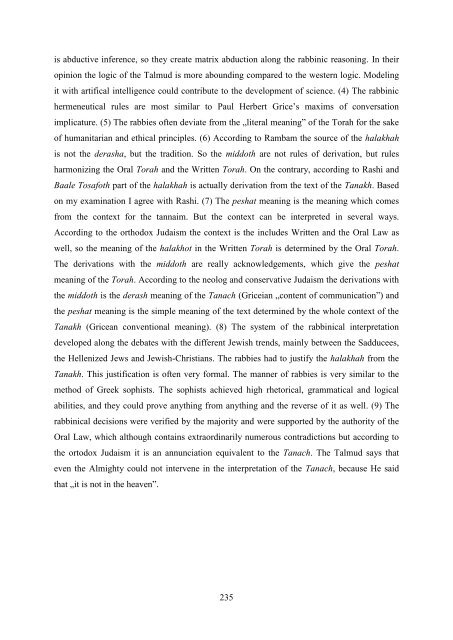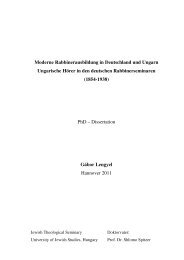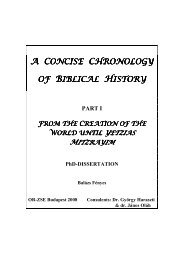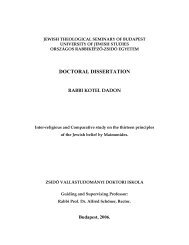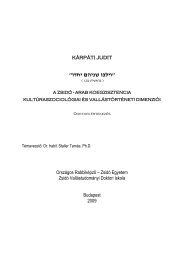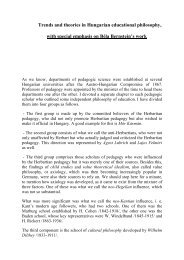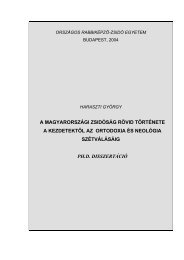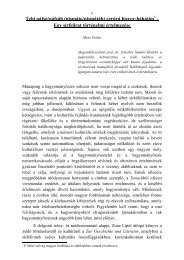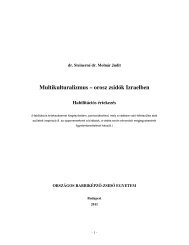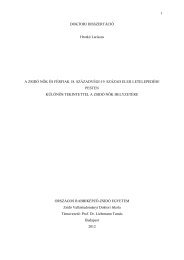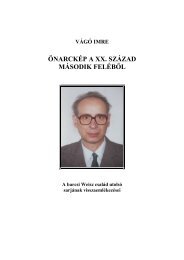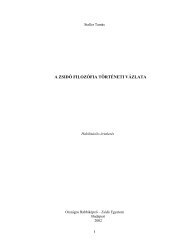Binján áv - A rabbinikus gondolkodásmód analÃzise egy ... - Or-Zse
Binján áv - A rabbinikus gondolkodásmód analÃzise egy ... - Or-Zse
Binján áv - A rabbinikus gondolkodásmód analÃzise egy ... - Or-Zse
You also want an ePaper? Increase the reach of your titles
YUMPU automatically turns print PDFs into web optimized ePapers that Google loves.
is abductive inference, so they create matrix abduction along the rabbinic reasoning. In their<br />
opinion the logic of the Talmud is more abounding compared to the western logic. Modeling<br />
it with artifical intelligence could contribute to the development of science. (4) The rabbinic<br />
hermeneutical rules are most similar to Paul Herbert Grice’s maxims of conversation<br />
implicature. (5) The rabbies often deviate from the „literal meaning” of the Torah for the sake<br />
of humanitarian and ethical principles. (6) According to Rambam the source of the halakhah<br />
is not the derasha, but the tradition. So the middoth are not rules of derivation, but rules<br />
harmonizing the <strong>Or</strong>al Torah and the Written Torah. On the contrary, according to Rashi and<br />
Baale Tosafoth part of the halakhah is actually derivation from the text of the Tanakh. Based<br />
on my examination I agree with Rashi. (7) The peshat meaning is the meaning which comes<br />
from the context for the tannaim. But the context can be interpreted in several ways.<br />
According to the orthodox Judaism the context is the includes Written and the <strong>Or</strong>al Law as<br />
well, so the meaning of the halakhot in the Written Torah is determined by the <strong>Or</strong>al Torah.<br />
The derivations with the middoth are really acknowledgements, which give the peshat<br />
meaning of the Torah. According to the neolog and conservative Judaism the derivations with<br />
the middoth is the derash meaning of the Tanach (Griceian „content of communication”) and<br />
the peshat meaning is the simple meaning of the text determined by the whole context of the<br />
Tanakh (Gricean conventional meaning). (8) The system of the rabbinical interpretation<br />
developed along the debates with the different Jewish trends, mainly between the Sadducees,<br />
the Hellenized Jews and Jewish-Christians. The rabbies had to justify the halakhah from the<br />
Tanakh. This justification is often very formal. The manner of rabbies is very similar to the<br />
method of Greek sophists. The sophists achieved high rhetorical, grammatical and logical<br />
abilities, and they could prove anything from anything and the reverse of it as well. (9) The<br />
rabbinical decisions were verified by the majority and were supported by the authority of the<br />
<strong>Or</strong>al Law, which although contains extraordinarily numerous contradictions but according to<br />
the ortodox Judaism it is an annunciation equivalent to the Tanach. The Talmud says that<br />
even the Almighty could not intervene in the interpretation of the Tanach, because He said<br />
that „it is not in the heaven”.<br />
235


